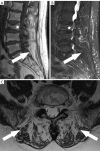Exploring the interplay between paraspinal muscular status and bone health in osteoporosis and fracture risk: a comprehensive literature review on computed tomography (CT) and magnetic resonance imaging (MRI) studies
- PMID: 38846277
- PMCID: PMC11151258
- DOI: 10.21037/qims-23-1770
Exploring the interplay between paraspinal muscular status and bone health in osteoporosis and fracture risk: a comprehensive literature review on computed tomography (CT) and magnetic resonance imaging (MRI) studies
Abstract
Background and objective: Computed tomography (CT) and magnetic resonance imaging (MRI) of the spine are fundamental non-invasive tools to investigate the status of the bone and soft tissue in vivo. A novel and promising approach is to investigate the quality and quantity of paraspinal muscles even beyond the clinical question. The aim of the present review is to summarize current evidence on CT and MRI about the relationship between paraspinal muscular status and bone health in osteoporosis (OP) and fracture risk.
Methods: Literature research was carried out on September 2023 using PubMed, Scopus, and Cochrane databases.
Key content and findings: Research investigating the intricate interplay between musculature and bone health reveals that degenerating paraspinal muscles, characterized by shrinking and fatty infiltration, are associated with lower bone mineral density (BMD) and the development of OP. Additionally, research indicates that weaker paraspinal muscles are linked to a higher risk of fractures, including those at the spine.
Conclusions: The findings suggest that paraspinal muscle health may be a significant factor in identifying individuals at risk for OP and fractures. Further investigation is needed to explore the potential of paraspinal muscles in preventing these conditions.
Keywords: Osteoporosis (OP); computed tomography (CT); magnetic resonance imaging (MRI); paravertebral muscles; spine; vertebral fractures.
2024 Quantitative Imaging in Medicine and Surgery. All rights reserved.
Conflict of interest statement
Conflicts of Interest: All authors have completed the ICMJE uniform disclosure form (available at https://qims.amegroups.com/article/view/10.21037/qims-23-1770/coif). C.A.M. serves as an unpaid editorial board member of Quantitative Imaging in Medicine and Surgery. The other authors have no conflicts of interest to declare.
Figures



Similar articles
-
Fatty infiltration of paraspinal muscles is associated with bone mineral density of the lumbar spine.Arch Osteoporos. 2019 Oct 15;14(1):99. doi: 10.1007/s11657-019-0639-5. Arch Osteoporos. 2019. PMID: 31617017 Clinical Trial.
-
Associations between paraspinal muscles fatty infiltration and lumbar vertebral bone mineral density - An investigation by fast kVp switching dual-energy CT and QCT.Eur J Radiol Open. 2022 Oct 14;9:100447. doi: 10.1016/j.ejro.2022.100447. eCollection 2022. Eur J Radiol Open. 2022. PMID: 36277658 Free PMC article.
-
Assessment of paraspinal muscle characteristics, lumbar BMD, and their associations in routine multi-detector CT of patients with and without osteoporotic vertebral fractures.Eur J Radiol. 2020 Apr;125:108867. doi: 10.1016/j.ejrad.2020.108867. Epub 2020 Feb 7. Eur J Radiol. 2020. PMID: 32065929
-
Vertebral Imaging in the Diagnosis of Osteoporosis: a Clinician's Perspective.Curr Osteoporos Rep. 2017 Dec;15(6):509-520. doi: 10.1007/s11914-017-0404-x. Curr Osteoporos Rep. 2017. PMID: 29103097 Review.
-
Computed Tomography Measured Psoas Cross Sectional Area Is Associated With Bone Mineral Density Measured by Dual Energy X-Ray Absorptiometry.J Clin Densitom. 2022 Oct-Dec;25(4):592-598. doi: 10.1016/j.jocd.2022.04.001. Epub 2022 Apr 29. J Clin Densitom. 2022. PMID: 35606278 Review.
Cited by
-
Magnetic resonance imaging-based bone and muscle quality parameters for predicting clinical subsequent vertebral fractures after percutaneous vertebral augmentation.Quant Imaging Med Surg. 2025 Feb 1;15(2):1480-1490. doi: 10.21037/qims-24-712. Epub 2025 Jan 22. Quant Imaging Med Surg. 2025. PMID: 39995724 Free PMC article.
-
Comparison of paravertebral muscle thickness and fatty infiltration in patients with osteoporosis, osteopenia and normal bone mineral density: a single-blind retrospective controlled trial.Eur Spine J. 2025 May 10. doi: 10.1007/s00586-025-08901-1. Online ahead of print. Eur Spine J. 2025. PMID: 40347291
References
-
- NIH Consensus Development Panel on Osteoporosis Prevention, Diagnosis, and Therapy. Osteoporosis prevention, diagnosis, and therapy. JAMA 2001;285:785-95. - PubMed
-
- Expert Panel on Musculoskeletal Imaging ; Ward RJ, Roberts CC, Bencardino JT, Arnold E, Baccei SJ, Cassidy RC, Chang EY, Fox MG, Greenspan BS, Gyftopoulos S, Hochman MG, Mintz DN, Newman JS, Reitman C, Rosenberg ZS, Shah NA, Small KM, Weissman BN. ACR Appropriateness Criteria® Osteoporosis and Bone Mineral Density. J Am Coll Radiol 2017;14:S189-S202. - PubMed
-
- Kazakia GJ, Carballido-Gamio J, Lai A, Nardo L, Facchetti L, Pasco C, Zhang CA, Han M, Parrott AH, Tien P, Krug R. Trabecular bone microstructure is impaired in the proximal femur of human immunodeficiency virus-infected men with normal bone mineral density. Quant Imaging Med Surg 2018;8:5-13. 10.21037/qims.2017.10.10 - DOI - PMC - PubMed
-
- Cheng X, Yuan H, Cheng J, Weng X, Xu H, Gao J, Huang M, Wáng YXJ, Wu Y, Xu W, Liu L, Liu H, Huang C, Jin Z, Tian W, Bone and Joint Group of Chinese Society of Radiology, Chinese Medical Association (CMA), Musculoskeletal Radiology Society of Chinese Medical Doctors Association, Osteoporosis Group of Chinese Orthopedic Association, Bone Density Group of Chinese Society of Imaging Technology, CMA . Chinese expert consensus on the diagnosis of osteoporosis by imaging and bone mineral density. Quant Imaging Med Surg 2020;10:2066-77. 10.21037/qims-2020-16 - DOI - PMC - PubMed
-
- Seeman E, Hopper JL, Young NR, Formica C, Goss P, Tsalamandris C. Do genetic factors explain associations between muscle strength, lean mass, and bone density? A twin study. Am J Physiol 1996;270:E320-7. - PubMed
Publication types
LinkOut - more resources
Full Text Sources
Miscellaneous
